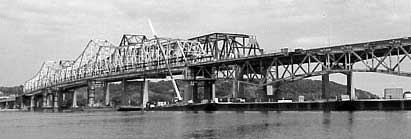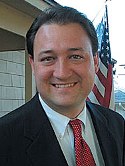Ever since Minnesota’s I-35W bridge collapsed, communities throughout the U.S. have started casting a concerned eye toward their own bridges. I asked City Manager Randy Oliver for some information about Peoria’s bridges and the city’s role, if any, in inspecting and maintaining them. Here’s what he said:
The bridges that are the City’s responsibility are primarily box culverts (e.g. concrete boxes with openings) which are more durable and require less maintenance. The State is responsible for all significant bridge structures over the River, Interstate and on State Routes.
The City is only responsible for and only inspects bridges that are the City’s responsibility. Inspection of the Murray Baker Bridge, for example, takes someone with specific technical skills and experience. We have not one with the skills or experience to inspect that type bridge.
So, it’s the State’s responsibility, and the State is taking action. The Chicago Tribune reports that “Gov. Rod Blagojevich on Thursday ordered state inspectors to examine all bridges considered to be critical.” That would include the Murray Baker and McClugage bridges.
The Federal Highway Administration (FHWA) maintains a National Bridge Inventory, which includes inspection information. I looked at the most recent inspection information available (2006) and found a couple of interesting items.
Bridges are given what’s known as a “sufficiency rating.” The FHWA defines it this way:
The sufficiency rating formula […] is a method of evaluating highway bridge data by calculating four separate factors to obtain a numeric value which is indicative of bridge sufficiency to remain in service. The result of this method is a percentage in which 100 percent would represent an entirely sufficient bridge and zero percent would represent an entirely insufficient or deficient bridge.
What are those four factors? They are (1) structural adequacy and safety, (2) serviceability and functional obsolescence, (3) essentiality for public use, and (4) special reductions. You can get a full explanation by reading the mind-numbing Recording and Coding Guide for the Structure Inventory and Appraisal of the Nation’s Bridges (1995).
The sufficiency rating of the bridge that collapsed in Minnesota was 50%, but that doesn’t really tell the whole story. Since there are four factors that go into that rating, not all pertaining to safety, it’s also important to look at the individual structural ratings. For instance, the superstructure of the I-35W bridge was rated as being in “poor condition.”
In the chart below, I’ve listed the 2006 ratings of Peoria’s bridges, along with three other scores indicating the condition of each bridge’s deck, superstructure (structure proper, bearings, joints, paint system, etc.), and substructure (piers, abutments, piles, fenders, footings, etc.):
| Bridge |
Rating |
Deck |
Super |
Sub |
| McClugage EB/US-24/150 |
63.5% |
8 |
5 |
5 |
| McClugage WB/US-24/150 |
89.0% |
6 |
6 |
7 |
| Murray Baker/I-74 |
60.1% |
7 |
6 |
7 |
| Bob Michel/IL-40 |
78.7% |
7 |
5 |
5 |
| Cedar Street/IL-8/29/116 |
65.3% |
7 |
5 |
7 |
| Shade-Lohmann EB/I-474 |
92.1% |
8 |
6 |
7 |
| Shade-Lohmann WB/I-474 |
80.0% |
8 |
5 |
7 |
| McNaughton/IL-9 (Pekin) |
83.0% |
7 |
5 |
8 |
Here’s what the ratings mean:
9 = EXCELLENT CONDITION
8 = VERY GOOD CONDITION – no problems noted.
7 = GOOD CONDITION – some minor problems.
6 = SATISFACTORY CONDITION – structural elements show some minor deterioration.
5 = FAIR CONDITION – all primary structural elements are sound but may have minor section loss, cracking, spalling or scour.
4 = POOR CONDITION – advanced section loss, deterioration, spalling or scour.
3 = SERIOUS CONDITION – loss of section, deterioration, spalling or scour have seriously affected primary structural components. Local failures are possible. Fatigue cracks in steel or shear cracks in concrete may be present.
2 = CRITICAL CONDITION – advanced deterioration of primary structural elements. Fatigue cracks in steel or shear cracks in concrete may be present or scour may have removed substructure support. Unless closely monitored it may be necessary to close the bridge until corrective action is taken.
1 = “IMMINENT” FAILURE CONDITION – major deterioration or section loss present in critical structural components or obvious vertical or horizontal movement affecting structure stability. Bridge is closed to traffic but corrective action may put back in light service.
0 = FAILED CONDITION – out of service – beyond corrective action.
As you can see, our bridges are in pretty good condition, but there is definitely room for improvement of some of them. To be eligible for funds from the federal Highway Bridge Replacement and Rehabilitation Program, “a bridge must carry highway traffic, be deficient and have a sufficiency rating of 80.0 or less.” It looks like we have a few that qualify.

 We don’t have to speculate any longer. The secret Bradley candidate for president is Joanne K. Glasser. The
We don’t have to speculate any longer. The secret Bradley candidate for president is Joanne K. Glasser. The  In Peoria, Arizona, it appears they have a
In Peoria, Arizona, it appears they have a 
 Former Peoria City Councilman
Former Peoria City Councilman